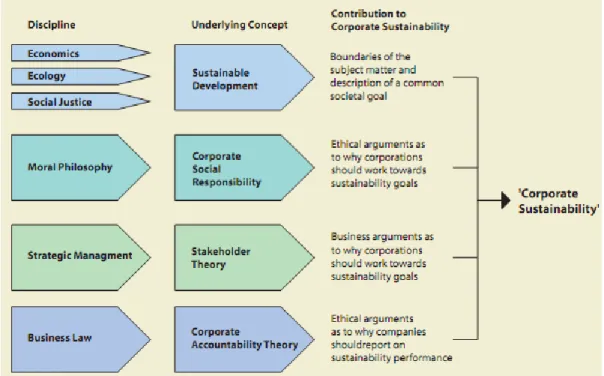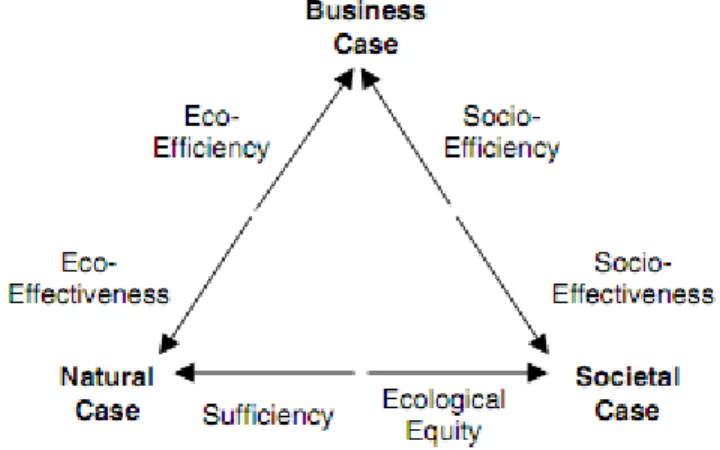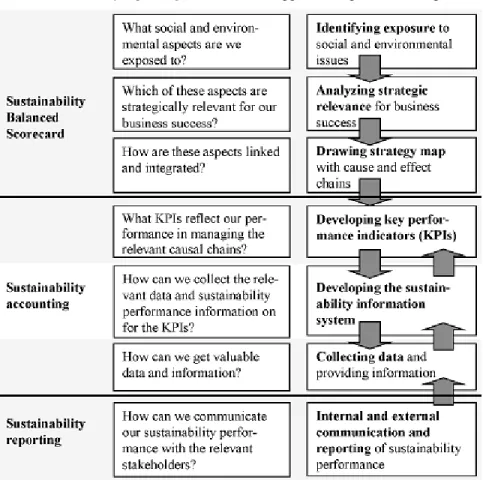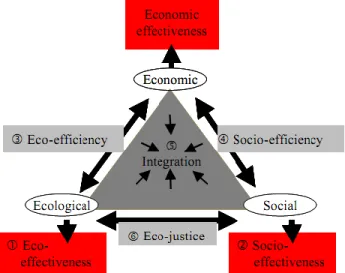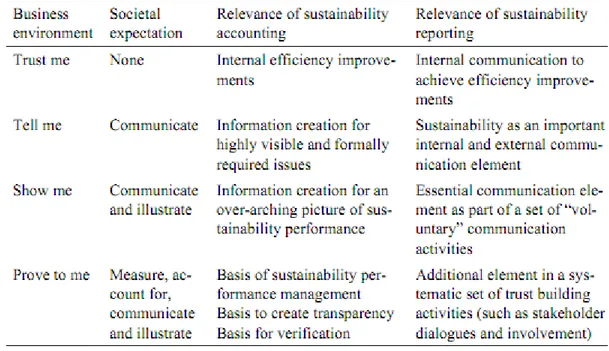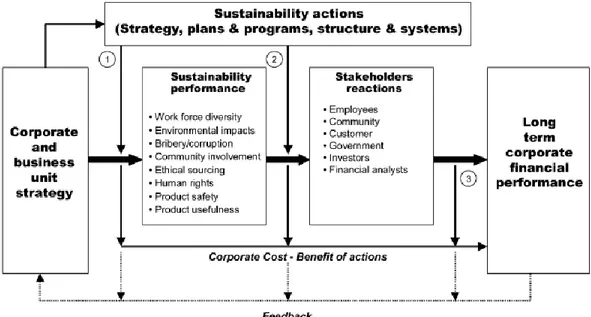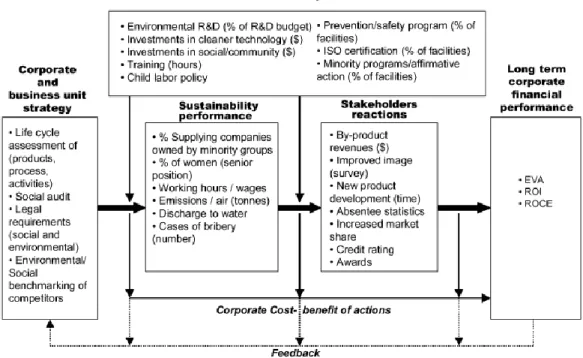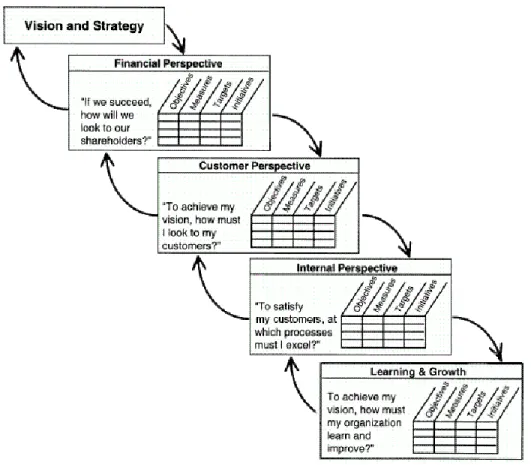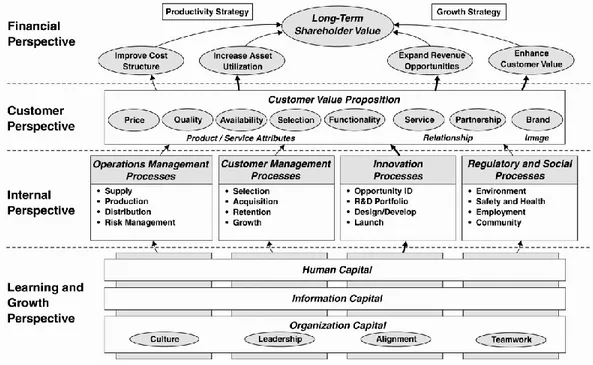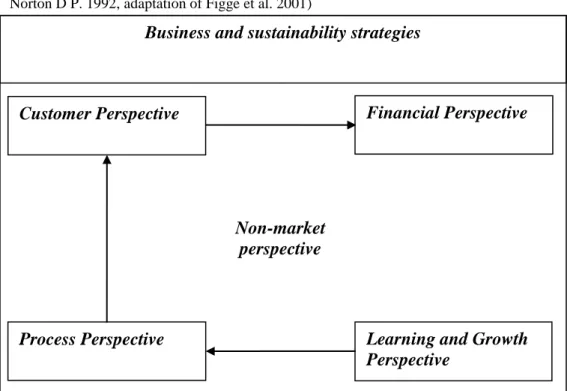Università di Pisa
Facoltà di Economia
Corso di Laurea Specialistica in Management & Controllo
Tesi di Laurea in Etica e Valori Aziendali
Corporate Sustainability and Balanced Scorecard:
Integrated Management of Economic, Environmental and
Social Performances in the Airline Industry
Candidato Relatore
Gaspare Zambito
Prof. Luca Nannini
Corporate Sustainability and Balanced Scorecard:
Integrated Management of Economic, Environmental and
Introductive Note
This work is the result of a research traineeship accomplished at the Institute of Public Administration and Law in the Faculty of Economics and Administration of the University of Pardubice in Czech Republic. The six months-traineeship is been carried out through the
Erasmus Placement Program. The Thesis abroad is been developed with the support of the scholarship “contributo di mobilità per tesi all’estero” granted by the University of Pisa
Acknowledgments
I want to say thanks to my Erasmus Placement Tutor Eng. Ticiano Costa Jordao from the Institute of Public Administration and Law (Faculty of Economics and Administration - University of Pardubice). For the whole semester and even beyond the internship period,
he supported me with high capability, professional attitude and always interested on my work, giving me the right motivation and willing to attain all the purposes assigned.
Thanks also to my Thesis Supervisor Prof. Luca Nannini that gave me the chance to go and develop my thesis project abroad. During the period spent in Czech Republic, he followed my work from distance with interest. Afterwards he helped me to complete the work in Italy
Contents
- Introduction 6
Chapter 1
Corporate Sustainability and Business Management
1.1 Corporate Sustainability 10
1.1.1 The Evolution of Corporate Sustainability 12 1.1.2 Business, Societal and Natural Cases of Sustainability 15
1.2 Sustainability and Competitiveness 20
1.3 Steps towards Sustainability Management 25
1.3.1 Stakeholders and Exposures 27
1.3.2 Leadership and Strategy 28
1.3.3 Actions 30
1.3.4 Organizational Structure and Management Systems 31
1.3.5 Measurement and Communication 34
1.3.6 Stakeholder Reaction, Financial Performance and Feedback 40
Chapter 2
Sustainability Balanced Scorecard
2.1 Traditional Balanced Scorecard 44
2.2 Integrating Environmental and Social Aspects: Towards Sustainability
Balanced Scorecard 48
2.3 The Process of Implementing a SBSC 53
2.3.1 The Practical-Technical Process 53
Chapter 3
Corporate Sustainability in the Airline Sector: Simulation of SBSC in Lufthansa
3.1 Airline Sector and Sustainable Development 64
3.2 The Case of Corporate Sustainability in Lufthansa 70 3.2.1 Lufthansa Overview and General Strategies 71 3.3 The Implementation of Sustainability Balanced Scorecard within the
Business Segment “Lufthansa Passenger Airline” 74
3.3.1 Environmental and Social exposures 74
3.3.2 Developing Sustainability Guidelines 77
3.3.3 Perspectives Objectives and Related Indicators 86
3.3.4 Strategy Map 95
3.4 Sustainability Performance Data, Comparison with Competitors, some
Criticisms and Suggestions 98
3.4.1 Transport Performances and related Economic-Financial Results 100
3.4.2 Environmental Performances 104
3.4.3 Social Performances 107
3.4.4 Community Performance 110
3.4.5 Sustainability Reporting and Stakeholder Dialogue 111
- Conclusions 115
Introduction
Global climate change, water, air and soil pollution, resources overuse, social inequalities, human rights, workers rights, child labor, consumers and employees safety constitute ethical concerns that world society must increasingly tackle. Many subjects are responsible for the mentioned troubles and several kind and levels of responsibilities can be associated to these subjects. Corporations can be considered the main responsible actors in the world for affecting natural environment and social constructs. There is no doubt that companies must consider their social responsibility and specifically the environmental, social and economic impacts of their activities on all stakeholder categories. The reasons why firms try to behave ethically are switching from the legal field to the competitive one. Many companies adapt their activities and processes in compliance with laws and rules of the markets in order to avoid charges of taxes, penalties and fees. But many other businesses are moving towards a responsible business in order to be more efficient, reduce cost, differentiate products, satisfy customers, motivate employees, access to ethical funds and acquire image and reputation. In this way, the social responsibility of a company is seen as matter of competitive advantage. The task of corporate managers regards the integrated management of environmental, social and financial issues towards better sustainable performances. Business practices known as Corporate Social Responsibility (CSR) or Corporate Sustainability are increasingly utilized through the development of strategies oriented to sustainable development in parallel with profitability. The development of sustainability strategies is certainly a big task for top management but the larger challenge is the implementation of these strategies. In other words, the matter is “how” to integrate the environmental, social and economic impacts into daily management decisions and operations.
The Balanced Scorecard (BSC) is the appropriate managerial instrument useful for the purpose of translating strategies into actions. This can be true for sustainability guidelines as well. The multidimensional conception of the tool can help to integrate the environmental and social aspects of the business activity with the four traditional perspectives of management (financial, customer, processes, learning and growth). With the support of balanced scorecard, many companies have been able to connect business
strategy with daily operations. The emerging concept of Sustainability Balanced Scorecard (SBSC) is referred to the same managerial tool but with the additional feature of considering the environmental and social issues connected directly or indirectly with the execution of the business processes. Objectives and indicators are not regarding only economic and financial goals but they are developed with contents of social and environmental purposes. Finally, cause and effect chains among strategic objectives in the SBSC show the relations between better environmental-social performances and increasing competitiveness and profitability.
Airlines belong to one of those industrial sectors increasingly becoming more sensible with respect to sustainability performances. The case developed about the German carrier Lufthansa will help to better understand which dynamics are behind the corporate sustainability approach in a real company. More important, it will be demonstrated how sustainability strategy is translated into operative targets easier to measure, monitor and manage. The work is addressed to deepen the process for making sustainability real work. The implementation of a Sustainability Balanced Scorecard in the business segment Lufthansa Passenger Airline is a simulation based on real strategies of the carrier. The outcome is a process that goes from the establishment of long term sustainability strategy to the definition of short term targets to monitor through the key performance indicators developed. Taking as starting point the needs of stakeholders and the related environmental and social impacts generated, sustainability strategies are developed. The function of the balanced scorecard is to formalize these strategies as several strategic objectives belonging to the different perspectives of SBSC. Afterwards, for each sustainability objective, numerous key performance indicators are developed in order to monitor single operative aspects related to the achievement of objectives. Causal linkages among objectives show how responsible and sustainable performances are linked with competitive advantages and thus financial results.
The case is developed basing on strategies declared by the company in the web site, specifically for the “Passenger Airline” segment. The simulation is based on many contributions in the literature. Internal as well as external sources have been utilized for carrying out the work. Economic and sustainability data about the sector are taken from significant reports of the industry such as disclosures from IATA (International Air
Transport Association) ICAO (International Civil Aviation Organization) and ATAG (Air Transport Action Group). The process of implementation of SBSC is based manly on the general framework of Figge et al. (2002) and adapted with the real data of Lufthansa. The strategy map is drawn following the framework of Kaplan and Norton (2004), and the causal relationships are the results of intuitions based on the logical connections between the sustainability aspects identified. Most of the indicators utilized come from Lufthansa Balance (sustainability reporting), the Annual Report (financial statement) and other additional support information available in the web page of Lufthansa Responsibility. Among the other indicators utilized, some represent own source, others are based on external sources, adapted from sustainability reports of competitors, or taken from the Global Reporting Initiative sustainability reporting guidelines G3. Furthermore, the assessment of economic, environmental and social performances, through a comparison with competitors, is based on data disclosed in the corporate responsibility and sustainability reporting of the carriers analyzed.
The work is structured as follow.
The first chapter introduces the concept of Corporate Sustainability, the evolution and disciplines from where it comes from and the explanation of the major aspects of a sustainable business activity. Afterwards, the relationships between corporate sustainability and competitive advantages are described for better focusing on the matter. The chapter ends with the introduction of the steps for managing sustainability. The process contains the following phases: identification of stakeholders and exposures, development of sustainability strategies, leadership and commitment, organizational structure and culture, performance measurement systems, reporting and feedback.
The second chapter starts with a brief explanation of the concept of Balanced Scorecard with his traditional meaning. Then, environmental and social issues are implemented within the BSC in order to give rise to the concept of Sustainability Balanced Scorecard (SBSC). Finally, two complementary processes of developing the SBSC are presented. The first is more focused on the practical and measurement aspects of the tool; the other emphasizes the strategic function and the cultural change needed in the whole organization.
The third chapter is dedicated to the development of the case of Lufthansa. First of all, the airline industry is introduced and the problems regarding sustainable development in this
sector are observed. Some meaningful data are presented about the sector and sustainability performances. Then, the case of Lufthansa is introduced. The process to implement the Sustainability Balanced Scorecard in the business segment Passenger Airline can be considered the core issue of the work. Detailed objectives, based on real strategies of the airline, with respective key performance indicators are developed and listed. The establishment of targets and initiatives makes feasible the translation of Lufthansa sustainability strategies into actions of the daily management. The strategy map, finally, illustrates the cause and effect connections among the various objectives, emphasizing the relations between sustainability performances and financial results. The case ends with the assessment of sustainability performances (economic, environmental and social) achieved by the German carrier through the comparison with the results obtained by the direct European competitor, Air France KLM, and other minor competitors.
Chapter 1
Corporate Sustainability and Business Management
1.1 Corporate Sustainability
One of the most important challenges that world is facing in 21ts century concerns sustainability development. The matter of a development towards a fair and wealthy society, pointing to preservation of natural environment and cultural improvements for future generations, is increasing importance day by day. The goal of reaching simultaneously economic growth, environmental protection and social equity is affecting more and more the business environment and not only Governments, special Authorities and Organizations. The issue of incorporating sustainable and responsible practices into daily business operations is increasingly becoming one of the major interests of corporations.
Companies are paying more attention to sustainable development for many reasons: compliance of Government regulations and industry codes of conduct; relations with community represented by general public and activist NGOs; cost and revenue imperatives related to the financial value achievable through sustainability performances; societal and moral obligations1. In particular, ten market forces that drive organizations to corporate sustainability have been identified by Bob Williard2. Five of these forces (mega-issues) represent the up coming problems for the companies:
- Climate Change - Pollution/health
- Globalization backlash - Energy crunch
1 Epstein M J. 2008. Making Sustainability Work. Best Practices in Managing and Measuring Corporate Social, Environmental, and Economic Impacts. Berrett-Koehler Publisher, San Francisco
2
Williard B. 2005. The Next Sustainability Wave: Building Boardroom Buy-In. Gabriola Island, British Columbia. New Society Publisher
- Erosion of trust
The other five forces concern the main stakeholder categories demanding a change towards more ethical and responsible behaviour:
- Green consumers - Activist shareholders - Civil society and NGOs - Governments and regulators - Financial community
Because of the mentioned reasons, corporations have become more sensitive to social issues and stakeholder concerns, trying to be more responsible and accountable. Business managers have been facing the need of being sustainable by implementing environmental management systems (EMAS, ISO 14000), executing environmental and social audits and developing environmental and social accounting and reporting systems. But the emerging challenge concerns the incorporation of sustainability issues into business strategy, with the purpose to manage the integrated economic, social and environmental aspects as daily operations. The development of strategies based on sustainability development and responsibility is going beyond the purpose of the mere compliance of legislation and regulations. The emerging goal of corporate sustainability is about acquiring further distinctiveness for competition. But what is exactly corporate sustainability? Where does it come from?
The term “corporate sustainability” has gained, in recent years, substantial interest among business managers, academic researchers and popular press. Actually there is not a commonly accepted definition and it is still a broad approach that embraces several characteristics concerning the integration of economic, environmental as well as social aspects of a business. Even the term “sustainable” has become a buzzword that everybody interprets in a different way such as “green, eco-efficient, ethical, socially responsible etc”.
It becomes more complicated when the term is associated to corporate dimension3. In some cases the term “corporate sustainability” is used in combination or in replacement with other terms such as “corporate social responsibility” or “sustainable development”4
. Next two paragraphs, based on two interesting articles, will explain the concept of corporate sustainability; afterwards it will be showed the connections between corporate sustainability and competitiveness.
1.1.1 The Evolution of “Corporate Sustainability”
One interesting contribution about the concept of “Corporate Sustainability” is given by Mel Wilson in his article “Corporate sustainability: what is it and where does it come
from?”. It deepens the evolution of corporate sustainability, showing the different
disciplines from where it comes.
“A review of the literature suggests that the concept of corporate sustainability borrows elements from four more established concepts: 1) sustainable development, 2) corporate social responsibility, 3) stakeholder theory, and 4) corporate accountability theory”5.
The concept of “sustainable development” is been introduced in 1987 by the World Commission for Environment and Development (WCED) through the publication of a book entitled “Our Common Future”6. It defines sustainable development as: “meeting the needs
of the present without compromising the ability of future generations to meet their own needs”. In this book it is underlined that companies have caused most of pollution,
damaged and wasted natural resources. At the same time they have the possibility to access to the resources required to solve these problems, thus they acquire a crucial role in growing towards sustainable development. It is matter of balancing economic growth with
3 Hockerts K. 2001. Corporate Sustainability Management. Toward controlling corporate ecological and social sustainability. Ninth International Conference of Greening of Industry Network, January 21-25, 2001, Bangkok
4
Wilson M. 2003. Corporate sustainability: What is it and where does it come from? Ivey Business Journal March/April
5 Wilson M. 2003. Corporate sustainability: What is it and where does it come from?. Ivey Business Journal March/April
6
WCED (World Commission for Environment and Development). 1987. Our Common Future. Oxford University Press
social equity and environmental protection. But this concept alone does not provide the sufficient explanation of why companies should move towards corporate sustainability. Another concept that brings elements of sustainability within businesses is “corporate social responsibility” (CSR). It regards the role, and precisely the ethical obligations and responsibilities, of companies in respect to the needs of society. CSR concerns moral philosophy in managing business. It comes from four philosophical theories7.
- Social contract theory: “according to this theory, corporations, as organizations, enter into contracts with other members of society, and receive resources, goods, and societal approval to operate in exchange for good behavior”.
- Social justice theory: “a fair society is one in which the needs of all members of society are considered, not just those with power and wealth. As a result, corporate managers need to consider how these goods can be most appropriately distributed in society”.
- Rights theory: “while shareholders of a corporation have certain property rights, this does not give them license to override the basic human rights of employees, local community members, and other stakeholders”.
- Deontological theory: “everyone, including corporate managers, has a moral duty to treat everyone else with respect, including listening and considering their needs”. The third concept, coming from the discipline of strategic management, is “stakeholder theory”. “Stakeholders are any group or individual who can affect or is affected by the achievement of the organization’s objectives”8. From this definition it could be deducted that stronger relationship with stakeholders are fundamental to reach company’s objectives and gain competitive advantage. The relation should focus on mutual respect, trust and long term cooperation. Hence, once the main stakeholders have been identified (shareholders, investors, customers, suppliers, employees, communities, NGO, governments, authorities etc.), corporate strategies should be developed for interacting with them9.
7 Wilson M. 2003 p.3 8
Freeman R E. 1984. Strategic Management: a Stakeholder Approach. Pitman Books, Boston, Mass 9 Wilson M. 2003
Finally corporate sustainability comes from “corporate accountability” theory. This concept concerns the moral duty of companies to report about sustainability performances. It consists in providing to the society information, explanations and reasons of the actions taken, thus showing the good behavior and motivating the bad one. The relation between the firms and its stakeholders should be supported by a report that should focus on environmental and social performances not only on economic ones10.
The following illustration (figure 1) summarizes the evolution of corporate sustainability. It comes from several concepts (on the center) deriving from different disciplines (on the left). The concept of corporate sustainability can be considered as the “sum” of the various contributions (on the right) belonging to the disciplines.
10 Wilson M. 2003
1.1.2 Business, Societal and Natural cases of Sustainability
Another important contribution in the literature that helps to understand the practical meaning of corporate sustainability is: “Beyond the business case for corporate
sustainability” by Thomas Dyllick and Kai Hockerts (2002). Taking as starting point the
definition of “sustainable development”: “meeting the needs of the present without
compromising the ability of future generations to meet their own needs”11
, they defined corporate sustainability as: “meeting the needs of a firm’s direct and indirect stakeholders
(such as shareholders, employees, clients, pressure groups, communities etc), without compromising its ability to meet the needs of future stakeholders as well”12
. Dyllick and
Hockerts based their work on the “triple bottom line” concept13
(see figure 2). Firms should be able to manage economic, social and environmental performances (people, planet and profit) in an integrated way. Each dimension of sustainability represents already a big challenge to manage, but Elkington noticed that: "some of the most interesting challenges, however, are found not within but between the areas covered by the economic, social, and environmental bottom lines”. They are what Elkington defines the “shear zones”14
.
11 WCED (World Commission for Environment and Development). 1987. Our Common Future. Oxford University Press
12 Dyllick T, Hokerts K. 2002. Beyond the business case for corporate sustainability. Business Strategy and the Environment 11, 130-141
13 Elkington J. 1997. Cannibals with Forks: the Triple Bottom Line of 21st Century Business. Capstone,
Oxford
14 Elkington J. 1997 p.70
Figure 2: The three Dimensions of Sustainability (from “Triple Bottom Line” concept by Elkington 1997, source: Dyllick T, Hokerts K. 2002 p.132)
In conjunction with the Triple Bottom Line concept of corporate sustainability and the “shear zones”, Dyllick and Hockerts developed their framework. After having identified the three kind of capital: economic, environmental and social, they recognized different properties and thus different approach and purposes of management towards sustainability. Economic capital is still far to be very well understood and there are many approximations and estimations in defining financial, tangible and intangible capital. Despite this problem, managing it in a sustainable way is not a new challenge of the businesses. “Economically
sustainable companies guarantee at any time cash-flow sufficient to ensure liquidity while producing a persistent above average return to their shareholders”15
.
Regarding the natural capital they classified two main types: natural resources and ecosystem services. The firsts, used in the production processes, could be renewable (wood, food, wind etc.) or non-renewable (fossil fuel, soil quality etc.). The second kind of natural capital (climate stabilization, water purification soil remediation, reproduction of plant and animals) has very big importance and value for the whole society. Despite this fact, it is bad understood and very difficult to account. “Ecologically sustainable companies use only
natural resources that are consumed at a rate below the natural reproduction, or at a rate below the development of substitutes. They do not cause emissions that accumulate in the environment at a rate beyond the capacity of the natural system to absorb and assimilate these emissions. Finally they do not engage in activity that degrades eco-system services”16
.
The social capital is also divided in two main types: human capital and societal capital. The first is about skills, motivation and loyalty of employees and partners. The second concerns the quality of public services given as education, culture, infrastructures etc. “Socially
sustainable companies add value to the communities within which they operate by increasing the human capital of individual partners as well as furthering the societal capital of these communities. They manage social capital in such a way that stakeholders can understand its motivations and can broadly agree with the company’s value system”17
. Dyllick and Hockerts noticed also some characteristics of natural and social capital that create problems of managing them in a sustainable way. The non-substitutability of capital
15 Dyllick T, Hokerts K. 2002 p.133 16
Dyllick T, Hokerts K. 2002 p.133 17 Dyllick T, Hokerts K. 2002 p.134
is one of them. The economic capital cannot substitute all kind of environmental capital (see ecosystem services for example). The same is true for social capital (societal capital more difficult than human capital); it can be substituted until certain thresholds. Another feature that generates troubles in managing sustainability is the irreversibility of environmental and social capital. Some kind of environmental (biodiversity, soil erosion etc) and social impacts (cultural diversity) are definite and thus cannot be reversed. Last but not least is the non-linearity of capital depletion. Usually the consumption of natural and social capital has no impact until some limits are reached.
Based on the above classification and according to the “shear zones” of the “triple bottom line” concept, Dyllick and Hockerts identified three cases of sustainability. They concern the integrated management of sustainability challenges by linking the three dimensions of sustainability, overcoming the conviction to manage them separately18. In other words, the three cases of sustainability regard the management of the “shear zones” defined by Elkington.
The first case of sustainability is the “business case”. It regards the management and improvement of economic sustainability by focusing, and hence increasing, the environmental and social efficiency. Eco-efficiency is the main criteria followed by many companies to manage sustainability. The WBCSD (World Business Council for Sustainable Development) specifies some indicators of eco-efficiency19. They are about reducing material, energy and water intensity, reducing waste and toxic emissions, improving recyclable policy. More in particular “eco-efficiency is calculated as the economic value added by a firm in relation to its aggregated ecological impact”. On the other hand, “socio-efficiency describes the relation between a firm’s value added and its social impact”. It has to be noticed that, differently than environmental impacts, social impacts can not be only negative but positive as well20.
Improving eco- and socio-efficiency is important but it does not solve the overall problem of sustainability. Due to the non-substitutability, non linearity and irreversibility of natural and social capital, it should be taken into account not only relative improvements but also
18 Elkington J. 1997
19 WBCSD (World Business Council for Sustainable Development). 1992. Changing Course. United Nation Conference on Environment and Development (UNCED), Rio de Janeiro
absolutes values of the impacts. The “natural case” regards ecological sustainability. It can be achieved by two paths: eco-effectiveness and sufficiency. The first consists in focusing and thus reducing absolute amount of emissions, materials, waste, etc. The second is a criterion that sees companies responsible of customer choices towed by brand and marketing policies adopted.
Finally there is the “societal case”. The first principle to reach social sustainability is socio-effectiveness. From this perspective “business conduct should be judged not on a relative scale but rather in relation to the absolute positive social impact a firm could reasonably have achieved”21
. Food or pharmaceutical industries, for example, should strive in providing its products to poor countries as well. The other guiding principle is ecological equity. The current generation that is consuming the world’s natural capital, should take care about the consequences that future generations will receive. A problem related to this criterion is the total lack of indicators that can drive companies to this kind of sustainability.
The following picture (figure 3) shows the three different cases of sustainability with the specifics challenges that occur within the “shear zones”.
21 Dyllick T, Hokerts K. 2002 p.138
Figure 3: Business, Natural and Societal Cases of Sustainability (source: Dyllick T, Hokerts K. 2002 p.138)
Although the three cases of sustainability represent the foundations of sustainability performance, a deeper explanation could help to understand which aspects are important in managing practically sustainability within a business reality. Epstein and Roy22 classified nine principles of sustainability:
- ethical standards and practices in dealing with all stakeholders - governance based on trust, consciousness and effectiveness - transparency of information disclosures
- fair business relationships
- financial return to investor and lenders
- community involvement and economic development
- value of products and services (respect needs, desires and rights of customers) - employment practices (development, diversity and work conditions of employees) - protection of the environment
From these values, corporate sustainability can be seen more as a practical matter of management; discussions, analysis, measurements and reports about sustainability issues, in the business reality, are related mainly to the above cited principles23.
This section provided the theoretical and practical definition of corporate sustainability, and identified the disciplines that embrace the evolution of the concept. Corporate sustainability is an evolutionary concept coming from different disciplines and concerning the integrated management of economic, environmental and social aspects of an Organization. The interest of companies for achieving environmental protection and social equity simultaneously with profit, is acquiring a growing importance nowadays. The reasons go beyond the compliance with legislation and embrace the field of competition. Next section will try to find the connections between sustainability and competitive advantage.
22 Epstein M J, Roy M J. 2003. Improving Sustainability Performance: Specifying, Implementing, and Measuring Key Principles. Journal of General Management 29,I: 15-31
1.2 Sustainability and Competitiveness
Many people from the academic world as well as the business environment have been interested in finding the relations between corporate sustainability and competitive advantages. The KPMG International Survey of Corporate Responsibility Reporting 200824 documented that there are eleven motivations why companies take the path of sustainability for competitive reasons:
- Ethical considerations - Economic considerations - Reputation or brand - Innovation and learning - Employee motivation
- Risk management or risk reduction - Strengthened supplier relationship
- Access to capital or increased shareholder value - Market position (market share) improvement
- Improved relationships with governmental authorities - Cost savings
Depends on the level of commitment and formalization of practices towards environmental protection and social equity simultaneously with profitability, sustainability becomes increasingly a strategic success factor. In order to achieve satisfactory performances in the aspects above mentioned, companies must consider corporate sustainability as part of their business strategy. In the “path to corporate responsibility” of Zadek25
five stages of organizational learning represent the level of commitment and formalization of sustainability practices. The stages are classified as follow:
- defensive, denying every kind of responsibility on the actions taken;
24
KPMG International Survey of Corporate Responsibility Reporting 2008 P.18 25 Zadek S. 2004. The path to corporate responsibility. Harvard Business Review
- compliance, adapting responsibility policies as a cost of business; - managerial, integrating sustainability with daily business operations; - strategic, implementing sustainability into business strategy;
- civil, promoting and collaborating with competitors towards responsible business.
The strategic stage is strongly related to the acquisition of competitive advantages of the first movers. Many industrial sectors such as automobile, food and pharmaceutical are becoming more sensitive to responsible practices. Evidently, in the future, sustainability will increasingly represent a main critical success factor. The strategic relevance of sustainability is emphasized by many other authors. The “strategic frontier” of “the virtue matrix” of Roger Martin26
is defined as those intrinsic responsible behaviors that bring benefits to shareholders and society simultaneously. Companies that first move to this frontier will get the advantage to be unique, dragging the behavior of competitors. The “logic of social and ecological transformation” represented by Hockerts27
shows three levels of transformation towards corporate sustainability. The cognitive level is based on the sole measurement of ecological and social impacts; the normative level takes into account stakeholder perceptions and claims voiced via the market, politics and public; finally, in the competitive level, these claims are turned into fields of competitive advantage through cost and differentiation strategies. But how do firms acquire distinctiveness through the responsible behavior? What are specifically the aspects on which the competition is based?
Many contributions in the literature are treating the relations between corporate sustainability and competitive advantages. Mario Minoja28 identified three types of positive impacts from corporate social responsibility (CSR here is meant as the large conception of corporate sustainability) to competitiveness. Firstly, CSR is considered as an integrative value proposition to customers. They can acquire both, tangible advantages directly deriving from socially responsible attributes of the products or intangible advantages based
26
Martin R L. 2002. The Virtue Matrix: Calculating the return on Corporate Responsibility. Harvard Business Review
27 Hockerts K. 2001 based on Dyllick et al. 1997
28 Minoja M. 2008. Responsabilità sociale e strategia: alla ricerca di un’integrazione. Chapter 4: Le relazioni fra vantaggio competitivo, profitto e “socialità” nelle imprese che integrano la RSI nella strategia. Egea, Milano
on ethical values. In both of cases the positive effect is that more customers will be willing to buy the product or pay a premium price for it.
Secondly, CSR could facilitate the access to resources valuable, rare and difficult to imitate that can help to improve the positioning of the firms in the competitive contest in which it operates. These resources are classified as follow.
- Human resources and professionals skills. Socially responsible organizations are more able to attract, keep and motivate the best employees.
- Capital. Reduction of legal, reputation and enterprise risks together with ethical preferences of some investors, aid the access to financial capital.
- Agreement with society. By developing policies of corporate citizenship, organizations will increase relations with local communities, governments and other authorities in order to acquire legitimacy to act.
- Trust and reputation. They cannot be acquired in the market of strategic factors but depend on past good actions and future perspectives.
Finally, the social cohesion is the third type of positive impact coming from CSR. Good social performances will increase stakeholder relationships. In some cases, such as change in the strategy, is required a common sacrifice from stakeholders. Social cohesion regards the unity of strengths coming from all stakeholders for a structural change within the organization.
Another contribution that emphasizes the positive synergy between social strategies with economic and competitive results is from Chirieleison29. The investment for improving social performances contributes to create the strategic positioning, differentiating the company with the other competitors in terms of social legitimacy, reputation, visibility and image. These differences will generate positive effects in the economic and financial performances. Similarly to Minoja contribution, the main ambits on which the synergies occur are:
29
Chirieleison C. 2002. Le strategie sociali nel governo dell'azienda. Chapter 3: Strategie Sociali e Performance Economico-Competitive. Giuffrè, Milano
- investment decisions of capital market;
- attraction, management and motivation of human resources; - customer choices.
Then, another deserving work is the Hockerts’ classification30 of competitive advantages deriving from sustainability transformation. He classified the advantages as follow:
- Relative cost advantages. A transformation in the competitive field that imposes higher costs to all firms can be faced by sustainability strategy that allows to meet the new requirements at relatively lower costs than competitors. One example is a tax on CO2 emissions. Companies that have already developed concrete plans to reduce carbon emissions will be less hurt by the tax than competitors.
- Relative differentiation advantages. Companies can differentiate their products through sustainability-related criteria. A good example is the “Fair Trade” label for those products characterized from a growing anxiety among consumers about unfair suppliers in the Third world. Some companies acquire relative advantages by offering “fair products”, to ethical consumers, at higher prices than normal ones.
- Absolute cost advantages. A sustainability-related investment could generate positive return even in an unchanged competitive field. For instance the purpose of decreasing the disposal costs can prompt companies to optimize the material flows. Procurement, inventory and handling costs could be also reduced. In this case the rising disposal cost has had a discovery function for decreasing other costs.
- Absolute differentiation advantages. Some sustainable innovations can help to discover new market niches. One example is the Smart car, introduced originally to be sold to young people who did not want big, environmentally unsustainable cars. But after it was bought also by elderly people willing to avoid the traffic problems in the city.
Other authors who have connected positively sustainability with competitive performances are Kaplan and Norton31. In the strategy map of the regulatory and social processes, the
aspects of financial perspective affected by sustainability practices (environment, safety and health, employment, and community) concern the reduction of business risks and the attraction of socially conscious customers and investors. In particular, based on Forest Reinhardt’s book32
“down to earth”, they identified five ways for achieving competitive advantage simultaneously with the improvement of environmental performances: cost reduction through total quality management and activity-based costing systems; product differentiation for “green customers” disposed to pay a premium price for “green products”; management of competitors by establishing new ecological standards for the sector; redefinition of markets through innovative product policies, and finally, the reduction of environmental risk (compensation and legal costs, boycotts, loss of reputation and image etc) related to potential environmental incidents.
Finally, another aspect of competitiveness acquirable through a responsible behavior regards the investment in the community and social projects in order to be a good corporate citizen. Cooperation with Non Government Organizations (NGO) seems to acquire notable importance. The article “Turning gadflies into allies” by Michael Yaziji33
emphasizes the role of NGOs in the society and the importance of partnering with them. Specifically, he identified four strengths of NGOs that represent, for corporations, threats and opportunities at the same time. These strengths consist in: legitimacy, awareness of social forces, distinct networks and specialized technical expertise. Because of this social power, companies that will collaborate and cooperate with NGOs can acquire many benefits. Yaziji recognized the following five benefits:
- Head off troubles by avoiding boycotts, loss of image and reputation, legal costs, etc. - Accelerate innovation. NGOs are requiring more than the mere economic results,
therefore companies will be motivated to improve societal and environmental aspects simultaneously with profits.
- Foresee shifts in demand. Since NGOs often leads social movements, consumers’ tastes can be influenced by awareness champagne about the “ethical content” of some
31 Kaplan R S, Norton D P. 2004. Strategy Maps: converting intangible assets into tangible outcomes. Chapter 6: Regulatory and Social Processes. Harvard Business School Press
32
Reinhardt F. 2000
products or services. In this way companies that collaborate can predict the demand of alternative ethical products or services.
- Shape legislation. NGOs can influence the Governments’ legislation about tax policies, regulations of competition, labor and environmental standard, etc.
- Set industry standards by the advantages of the first movers in being ethical business.
The interest in managing sustainability among firms is increasing constantly for reasons that goes beyond legislation and embrace the competitive sphere. The driving forces towards more responsible business are: legitimacy, freedom to act, proactive compliance, good image and reputation, process or product innovations, reduction of waste, eco-efficiency etc. These are some of the reasons why different businesses are moving towards sustainability. But how companies should face the implementation of sustainability in the business strategies? How do they should link them to daily operations? How do they should manage, account and report sustainability performances? Next section will try to give answers to these questions.
1.3 Steps towards Sustainability Management
Once the Top Management has decided to undertake the path of sustainability, general mission, strategies and operative activities must be aligned through the development, incorporation and communication of general objectives, principles, values, programs, methodologies and tools within all levels of business activity. In recent years many business realities have been facing with sustainable management by implementing Environmental Management Systems (EMS), acquiring certifications ISO 14000 or SA8000, developing variety of environmental and social accounting and reporting systems, etc. Nevertheless a common problem is been encountered: sustainability matters have been left out from the general management of the businesses by the development of separated and parallels management systems. The outcome of these choices has been the lack of priority in struggling environmental and social issues, whereas economic and financial
aspects were more important and imminent. However, in some cases, companies have linked sustainability guidelines with corporate strategies, making feasible the daily integrated management of economic, environmental and social aspects through the business operations. This latter approach is of course harder but ensures a real connection between the purposes of be responsible and the concrete actions to undertake.
There are many contributions in the literature concerning the implementation of sustainability issues into strategies and the related management of sustainability performances. In the book “Making Sustainability Work” by Epstein (2008) it is presented a well structured framework of the process for implementing sustainability. From the same author, in collaboration with Roy34, a further contribution is “Sustainability in Action:
Identifying and Measuring the Key Performance Drivers”. It focuses on the process to
make sustainability issues and goals concrete actions to take. Another interesting article is
“Integrative Management of Sustainability Performance, Measurement and Reporting” by
Stefan Schaltegger and Marcus Wagner35. The main point of this latter work concerns the integration of management tools utilized to make the above mentioned process (Epstein and Roy’s framework) feasible with the focus on the linkages between performance measurement and management system with sustainability reporting. With the main support of these contributions, below it is explained the process or better the steps that a company must make to move towards sustainability, from the main strategies and objectives, through the operative targets, to accounting and reporting of environmental, social and financial facts. The phases identified are the following36:
- Identification of stakeholders and related environmental and social exposures - Leadership and implementation of sustainability strategy
- Definition of concrete actions to take
- Design of organizational structure and management systems
- Measurement and communication through sustainability accounting and reporting
34
Epstein M J, Roy M J. 2001. Sustainability in Action: Identifying and Measuring the Key Performance Drivers. Long Range Planning 34: 585-604
35 Schaltegger S, Wagner M. 2006. Integrative management of sustainability performance, measurement and reporting. Int. J. Accounting, Auditing and Performance Evaluation, Vol. 3, No. 1
36
The phases are based mainly on: Epstein M J, Roy M J. 2001; and considering also: Epstein M J. 2008; Figge et al. 2002a, 2002b; Schaltegger S, Wagner M. 2006; Hinna L. 2005; The Copenhagen Charter 1999
- Stakeholders’ reaction, financial performance and feedback
1.3.1 Stakeholders and Exposures
A preliminary step that must be made concerns the analysis of current strategies with the purpose to understand if and how they could impact with sustainability issues like environmental pollution and damage, energy consumption, human rights, employee satisfaction, product responsibility, etc. This phase regards the identification of the key stakeholders and the measurement of the potential environmental and social impacts (exposures) that could represent critical success factors for the business success37. Stakeholders are all the subjects that primarily affect business performances and, at the same time, are largely affected from company's actions38; specifically, in the context of sustainable development, they are impacted by company's social and ecological policies and actions. Therefore it becomes crucial to understand which stakeholders are the most relevant and what kind of social or financial pressure they exercise to the company. The identification of key stakeholders could be done with the support of the matrix interest/influence39. The tool, advised in “The Copenhagen Charter”, can be useful to recognize which stakeholder category exercises high or low influence to the business activity and, at the same time, what kind of interest, significant or insignificant, the company detains for each category. Numerous classifications of stakeholders exist in both business and academic worlds: level of importance, strategic relevance, type of influence, kind of relation, etc. The following is my own general classification that includes all those actors which are affected and can affect somehow the firm existence.
- Shareholders
- Financial community - Employees
37 Epstein M J, Roy M J. 2001, Figge et al. 2002a, Schaltegger S, Wagner M. 2006, Hinna L. 2005 38 Freeman R E. 1984
39
The Copenhagen Charter. A Management Guide to Stakeholder Reporting. 1999. Ernst & Young, KPMG, PricewaterhouseCoopers, House of Mandag Morgen
- Customers
- Suppliers and parteners - Governments
- Non Government Organizations (NGO) - Science and Education
- Community
- Society (largely conceived)
After having classified the main stakeholder categories, the identification of the particular impact exercised for each category is easier. In order to be aware of how the firm actions are impacting stakeholders, it is necessary to identify the particular environmental and social exposures related to the company's industry, market, geographical location, process technology, labor policy and practices, etc. “Different types of tools and techniques can be used to measure potential social and environmental impacts of a company’s business activities” [….]. “Life Cycle Assessment (potential environmental impact through R&D, sourcing, manufacturing, packaging, marketing, sales, distribution, consumer use, and disposal) and social audits are powerful tools to help companies to better understand the environmental and social characteristics of their business activities”40. Stakeholders and exposures identified constitute the field of action for developing the sustainability strategies, the organizational structure, plans, programs and actions.
1.3.2 Leadership and Strategy
The starting point of the process towards corporate sustainability is a clear and strong commitment of top management to implement and communicate strategy. Board of directors, CEO and management must focus on the best ways of communicating vision, mission and strategy to all levels of organization. Corporate leaders must align business goals with environmentally and socially responsive activities, providing internal credibility to promote the improvement of social and environmental management within the whole
organization. The commitment of top management encourages the employees to behave in ways that are acquiescent and reliable with company strategy41.
Business strategy must be the starting point for sustainability. Corporate and business unit strategies regard the choices, the guidelines and the philosophies of a company's management to reach certain objectives established by a general mission. Formulating a strategy entails the examination of the kind of industry the company is operating, in which market it is competing, the ways how it is organizing the resources and utilizing the competencies42. Strategy defines the identity of a company in the relations with the environment (here refers to stakeholders), underlining what, why and how it does or it
wants to make the business activity43. Since managerial behavior and operative actions are affected by general strategy, internal and external drivers that can really address company's actions to integrated social, ecological and financial goals must be embodied into business strategies. In this sense, moving towards sustainability gives rise to the necessity of following a process to implement these new ecological and social philosophies and values inside the general guidelines of the business management.
Once stakeholders and relative impacts have been identified, next step consists in formulating the sustainability strategy. It should contain the main goals, the guidelines, the values and the obligations related to ecological and social issues such as emissions in the air and water, energy consumption, labor practices, employees diversity, etc. Epstein classified three stages of sustainability strategies that reflect the commitment towards full corporate sustainability44. Stage 1 is the simple management of regulatory compliance; stage 2 regards the achievement of competitive advantage; and stage 3 consist in the completion of social, economic and environmental integration. This latter stage is about managing sustainability as a routine in all the levels of the organization. In this sense, strategy must be made feasible, in other words, it should be adapted to the business unit
41 Epstein M J. 2008
42 For deepening the concept of “Strategy” see Coda V. 1995. L'orientamento strategico dell'impresa. Utet Università, Milano
43
Coda V. 1995 p.24 44 Epstein M J. 2008. p.64-67
level and the local daily operations. For this purpose it can be useful to deepen the concept of Balanced Scorecard45.
BSC is a management tool that translates strategies into actions. The major feature of this instrument is the multidimensional conception of business performances. For this characteristic it can efficiently face the main challenges of corporate sustainability management46; sustainability issues can be easily incorporated in the several management perspectives of balanced scorecard and the related performances can be monitored through adequate key performance indicators (KPI). KPIs are linked in cause and effect “chains” (strategy map) that focus on the relations between different objectives and perspectives, clarifying how environmental and social performances affect the financial ones47.
When the connection between sustainability strategy and operations is clear, next step is about planning the right actions in line with the general guidelines.
1.3.3 Actions
Based on the main objectives established, the third step is about planning concrete actions to carry out in order to be responsible and sustainable. Epstein and Roy, in their framework, have treated the development of plans and programs. They distinguished two ways of developing plans and programs. One regards the improvement of environmental and social performances. It could be made by improving the existing routines or facing radical changes. “They may include capital investments in new technologies, product or process redesign, or R&D spending, [...] programs to promote ethical sourcing, work force diversity, or more stringent codes of conducts in terms of labor practices”48. Further actions concern investments in social communities, training programs, ISO certifications, preventions and safety programs. The second way to develop plans and programs concerns the promotion of sustainability performance to the stakeholders. It provides at the same time responsibility as well as communication to stakeholders. “These initiatives may
45 Kaplan R S, Norton D P. 1996. The Balanced Scorecard: Translating Strategies into action. Harvard Business School Press: Boston
46 SBSC will be treated next chapter 47
Schaltegger S, Wagner M. 2006 48 Epstein M J, Roy M J. 2001 p.592
include marketing efforts to promote social and environmental product features, lobbying efforts to governmental agencies related to social and environmental issues, [...] community surveys to assess public opinion on the company’s social and environmental performance and community advisory panels”49
. In addition, external reports should be provided to stakeholders. They should contain information about sustainability policies, actions taken and results reached50. The actions mentioned regard only some of the possible ways for translating the strategies in terms of plans a programs.
Once leadership commitment is been addressed to the development and communication of sustainability strategies, and plans and programs have been established, companies need to implement them through appropriate organizational structures and management systems51. They will be presented in the next paragraph.
1.3.4 Organizational Structure and Management Systems
This phase could be considered as the hardest. Based in a change of corporate culture, it requires the alignment of strategy, organizational structure and management systems towards the coordination of activities and the motivation of employees.
The first step that must be made, in order to align organizational structure with sustainability strategy, is the involvement of the whole organization in the sustainability practices. By making a deep assessment of all the value chain activities, it is possible to identify the particular impacts that each functional area is exercising, the responsibilities and the potential ways to reduce these impacts. Both primary and support activities of the value chain are fundamental for reaching financial, ecological and social goals. Hence, each functional department must be involved in promoting sustainability52.
Afterward, the development of several management systems is crucial for supporting corporate sustainability. “To drive a sustainability strategy through an organization, various management systems such as product costing, capital budgeting, information, and
49 Epstein M J, Roy M J. 2001 p.592 50 Hinna L. 2005 51 Epstein M J. 2008 52 Epstein M J. 2008
performance evaluation must be designed and aligned”53
. Performance evaluation systems should be built and developed in order to monitor sustainability facts. Therefore, sustainability measures must be developed. Incentives and rewards should be established to drive managers and employees behavior to excellence in sustainability outcomes. In order to monitor and assess the actions taken, key performance indicators (KPI) should be elaborated. The strategies must be translated to measurable targets and other measures should be developed for monitoring the level of achievement of plans and programs.
One really interesting framework, given by Schaltegger and Wagner, concerns the integration of several management tools for supporting sustainability management. They have built a framework that links at first “business strategy with sustainability performance
measurement and management” and consequently “performance measurement and management with reporting and communication”54
. This link can be characterized by two perspectives: “outside-inward perspective” and “inside-outward-perspective”. The first, based on external considerations, “will screen publicly discussed issues, communicate the corporate contribution to these issues and thus define measurement and management activities on basis of these issues”. The latter approach “is based on the business strategy and the analysis of what issues are relevant for an effective implementation of the strategy and to succeed with this strategy”. They have focused their framework more on the “inside-outward-perspective”. It regards the strategic management of the crucial aspects of stakeholder relationship and thus which ones should be measured and managed in a communicative interaction. Is matter of selecting those sustainability performance indicators that are important for stakeholders and the business success55. “The management task is to identify strategy-related sustainability issues, to account for them and finally, to report them”56
. The result is an integrated framework for sustainability performance measurement and management that links several management tools: sustainability balanced scorecard, sustainability accounting and sustainability reporting (see figure 4).
53
Epstein M J, Roy M J. 2001 p.594
54 Schaltegger S, Wagner M. 2006. Integrative management of sustainability performance, measurement and reporting. Int. J. Accounting, Auditing and Performance Evaluation, Vol. 3, No. 1 p.3
55 Hinna L. 2005. Come gestitre la reponsabilità sociale dell’impresa. Chapter 6 Le fasi del processo di relazione con gli stakeholder nell’ambito dell’orientamento alla Rsi (The Copenhagen Charter). Il sole 24 ore 56 Schaltegger S, Wagner M. 2006. p.4
As showed in the figure 4, the main steps to reach this integration are:
- identification of environmental and social exposure of the business - analysis of strategic relevance of environmental and social aspects - development of causal chains and the strategy map
- definition of key performance indicators and development of the measurement methods to create the respective performance information
- consideration of the identified key sustainability performance indicators in the company internal and external communication and reporting activities
- BSC implementation, revision and reporting on sustainability indicators.
Figure 4: An integrated framework for sustainability performance
measurement and management linking the SBSC, sustainability accounting and sustainability reporting (source: Schaltegger S, Wagner M. 2006 p.5)
These steps made clear the linkages between SBSC, accounting and reporting system. General standard indicators based on the industry, sector etc, are taken into consideration (outside-inward-perspective) but the choices about key performance indicators (KPI) used in the overall performance system are mainly driven by strategic considerations and stakeholders relevance (inside-outward-perspective). Sustainability accounting system, then, provides the right elaborated data useful to feed reporting requirements as well as strategically relevant information. Sustainability performance management could be seen, in this way, “strategy-focused”. This means that operational activities are based on KPIs identified. For this purpose, accounting system needs a considerable change pointing to the implementation of environmental and social issues with their economic and financial impacts. The accounting system must be oriented towards the provision of the needed data for developing KPIs. The outcome is an accounting system characterized by a mix of several indicators: strategic and operational, monetary and non-monetary, quantitative and qualitative. Through such as accounting system, SBSC is linked to sustainability reporting. Next paragraph will be dedicated to the accounting and reporting systems.
1.3.5 Measurement and Communication
Sustainability accounting and reporting can be described as the system of activities and techniques to collect, processing and disclose information about environmental and social impacts, induced economic and financial outcomes, links and interactions between the three dimension of sustainability, social, environmental and economic. Therefore sustainability accounting can be considered as a new information management system while sustainability reporting concerns new way of communication based on the provision of information about corporate sustainability. Connection between accounting and reporting is fundamental; sustainability issues accounted must be communicated and information has to be trustworthy in order to create a feedback process of continuous development of accounting and communication practices towards the improvement of sustainability
performances57. This relation is reinforced by the strategic character of sustainability accounting; KPIs identified in SBSC approach have to be properly calculated and accounted in order to increase the quality of disclosure. Reliable and strategy-related reporting, by contrast, influence stakeholder reactions and feedback towards better accounting and performances58.
Among the major motivations for firms to make public sustainability reports there are: the communication with stakeholder about non-market issues, the motivation of employees to deal with sustainability, the scope to increase legitimacy, credibility and reputation among the society59. Recently it is increasing the necessity to standardize accounting, performance measurement and reporting procedures. The need of systematic measurement about social and environmental issues conducted to some initiatives (Global Reporting Initiative is the most important) pointing to the utilization of sector specific performance indicators. The trend towards the standardization will facilitate comparability and transparency of information between different firms. Standards will also help the development of a unique integrated accounting and reporting system. The existence of these reporting guidelines arises the problem of which way should be used to manage sustainability performances60: strategy and accounting-driven sustainability reporting (inside-out perspective) or reporting-driven sustainability accounting (outside-in perspective)? “Both the inside-out and the outside-in approaches are related to each other. On one hand, a good corporate strategy has to consider external stakeholder expectations and requirements and thus is not isolated from reporting requirements. On the other hand, good corporate reporting requires substantive performance results which can be demonstrated only on the basis of relevant, reliable, comparable and understandable information about corporate sustainability”61. But how are structured corporate sustainability accounting and reporting? Which are the main challenges that drive the accounting process? How is organized the “new sustainability information system”?
57 Schaltegger S, Bennett M, Burritt R. 2006. Sustainability Accounting and Reporting. Chapter 1: Sustainability Accounting and Reporting: Development, Linkages and Reflection. Berlin, Springer 1-33 58
Hinna L. 2005. The strategic relevance of the KPI and the functioning of sustainability accounting is better deepened in: The Prince’s Accounting for Sustainability Project 2007. Connected Reporting: a practical guide with worked examples. accountingforsustainability.org London
59 Hinna L. 2005 60
Schaltegger S, Bennett M, Burritt R. 2006 61 Schaltegger S, Bennett M, Burritt R. 2006 p.17
